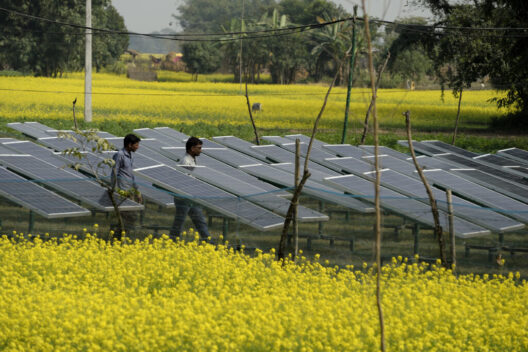Every day, the sun rises, showering our planet with an abundance of energy. But have you ever wondered how this celestial body can help mitigate the crises of global warming? The answer lies in solar panels, an ingenious innovation designed to harness solar energy, transform it into electricity, and reduce our reliance on fossil fuels. As we delve into the mechanisms by which solar panels prevent and reduce global warming, let’s consider a playful question: What if one day we could power the entire world using just the sun?
Solar panels convert sunlight into electricity using photovoltaic cells. When sunlight strikes these cells, it excites electrons, creating a flow of electricity. This process is not only efficient but also benign; it produces no harmful emissions during operation. In contrast to traditional energy sources, such as coal and natural gas, which release significant quantities of carbon dioxide (CO2) and other greenhouse gases into the atmosphere, solar power offers a clean alternative. By replacing fossil fuels with solar energy, we can substantially diminish the emissions that contribute to global warming.
Let us consider the global energy landscape. According to recent statistics, fossil fuels account for a disproportionate share of global energy consumption. This trajectory has dire implications for our climate, as increased CO2 concentrations in the atmosphere lead to rising temperatures, erratic weather patterns, and expanded droughts. However, increasing the adoption of solar panels can alter this detrimental trend. By investing in solar infrastructure, communities can mitigate their carbon footprints and transition towards a greener future.
The benefits of solar energy extend beyond mere emissions reduction. Solar panels often lead to decentralized energy generation. This decentralization empowers individuals and communities, reducing dependence on centralized power stations, which often rely on fossil fuels. For example, a neighborhood equipped with solar panels can generate its electricity, lowering demand from the grid and further decreasing reliance on non-renewable energy sources. This proactive measure not only bolsters energy security but also fosters a sense of community responsibility toward environmental stewardship.
Despite the evident advantages, a significant challenge persists: the initial cost of solar panel installation can be a barrier for many. While prices have steadily declined over the last decade, the upfront investment remains a deterrent for potential adopters. However, this challenge is being met with creative solutions such as financial incentives, tax credits, and innovative financing models, which enable more people to access solar technology. Additionally, as technology advances and economies of scale take effect, the expenses associated with solar energy are likely to continue their downward trajectory, making it an increasingly viable option for all.
Now, let us pivot our focus to the environmental impacts of solar panels. While the operational phase is environmentally benign, the manufacturing of solar panels does have ecological implications. The production process can involve the use of hazardous materials and energy-intensive manufacturing techniques. However, the overall lifecycle analysis has shown that the environmental benefits of solar energy generation substantially outweigh the impacts of production. Notably, the energy payback time—the duration required for a solar panel to generate the energy consumed during its manufacture—is typically within 1 to 4 years, and panels can remain productive for over 25 years. Ultimately, the numbers speak volumes: solar panels contribute to a drastic reduction in greenhouse gas emissions, making them a critical tool for combating climate change.
Moreover, solar energy can complement other sustainable practices and technologies. For instance, integrating solar panels with battery storage systems enables consumers to store excess energy generated during sunny days for consumption during nighttime or cloudy periods. This synergy not only enhances the efficiency of solar systems but also promotes energy resilience. Communities equipped with storage solutions can withstand grid outages or fluctuations, further cements the role of solar energy as a cornerstone of modern energy solutions.
Solar energy can also breathe new life into underprivileged communities. Whether it’s a rural area with limited access to electricity or an urban neighborhood plagued by energy poverty, solar panels can provide much-needed relief. By offering affordable and clean energy alternatives, solar installations can empower communities, enhance living conditions, and stimulate economic growth. This democratization of energy is paramount in the global struggle for equity and justice, especially as the impacts of climate change disproportionately affect marginalized populations.
As we reflect on the potential of solar energy, it becomes evident that the question isn’t whether solar power is a viable alternative anymore; the real challenge lies in its widespread adoption. As governments, corporations, and individuals grapple with climate change, the proactive embrace of solar technology can catalyze transformative change. Harnessing the sun’s energy allows us to innovate and rethink our relationship with the environment.
In conclusion, the role of solar panels in preventing and reducing global warming is undeniably significant. By curtailing greenhouse gas emissions, promoting energy independence, and facilitating technological innovation, solar energy emerges as a beacon of hope in the fight against climate change. As we stare into the future, it is imperative to foster a collaboration between stakeholders—citizens, policymakers, and businesses— to realize this potential. Let us seize the opportunity to power our lives with clean, renewable energy and strive toward a cooler planet for generations to come.








